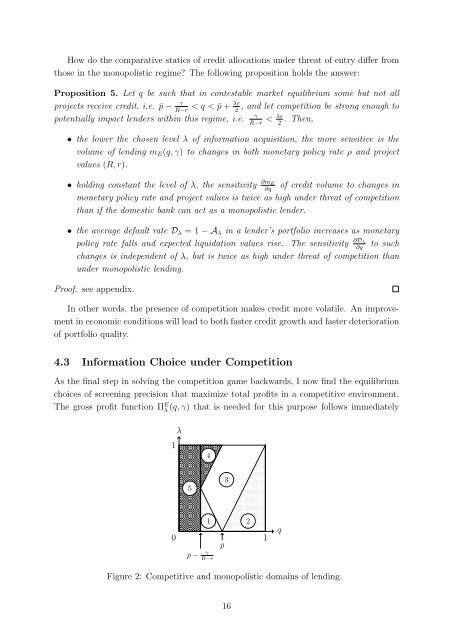Bank Competition, Information Choice and Inefficient Lending Booms
Bank Competition, Information Choice and Inefficient Lending Booms
Bank Competition, Information Choice and Inefficient Lending Booms
Create successful ePaper yourself
Turn your PDF publications into a flip-book with our unique Google optimized e-Paper software.
How do the comparative statics of credit allocations under threat of entry differ from<br />
those in the monopolistic regime? The following proposition holds the answer:<br />
Proposition 5. Let q be such that in contestable market equilibrium some but not all<br />
projects receive credit, i.e. ¯p −<br />
γ<br />
λε<br />
< q < ¯p + , <strong>and</strong> let competition be strong enough to<br />
R−r 2<br />
γ<br />
potentially impact lenders within this regime, i.e. < λε.<br />
Then,<br />
R−r 2<br />
• the lower the chosen level λ of information acquisition, the more sensitive is the<br />
volume of lending m E (q, γ) to changes in both monetary policy rate ρ <strong>and</strong> project<br />
values (R, r).<br />
• holding constant the level of λ, the sensitivity ∂m E<br />
of credit volume to changes in<br />
∂q<br />
monetary policy rate <strong>and</strong> project values is twice as high under threat of competition<br />
than if the domestic bank can act as a monopolistic lender.<br />
• the average default rate D λ = 1 − A λ in a lender’s portfolio increases as monetary<br />
policy rate falls <strong>and</strong> expected liquidation values rise. The sensitivity ∂D λ<br />
to such<br />
∂q<br />
changes is independent of λ, but is twice as high under threat of competition than<br />
under monopolistic lending.<br />
Proof. see appendix.<br />
In other words, the presence of competition makes credit more volatile. An improvement<br />
in economic conditions will lead to both faster credit growth <strong>and</strong> faster deterioration<br />
of portfolio quality.<br />
4.3 <strong>Information</strong> <strong>Choice</strong> under <strong>Competition</strong><br />
As the final step in solving the competition game backwards, I now find the equilibrium<br />
choices of screening precision that maximize total profits in a competitive environment.<br />
The gross profit function Π E λ (q, γ) that is needed for this purpose follows immediately<br />
1<br />
λ<br />
4<br />
5<br />
3<br />
1 2<br />
0 1<br />
¯p<br />
¯p −<br />
γ<br />
R−r<br />
q<br />
Figure 2: Competitive <strong>and</strong> monopolistic domains of lending.<br />
16
















